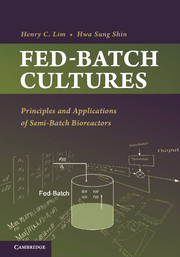Book contents
- Frontmatter
- Contents
- Preface
- Acknowledgments
- 1 Introduction to Fed-Batch Cultures
- 2 Idealized Reactors and Fed-Batch Reactors
- 3 Maximization of Reaction Rates and Fed-Batch Operation
- 4 Phenomena That Favor Fed-Batch Operations
- 5 Classification and Characteristics of Fed-Batch Cultures
- 6 Models Based on Mass Balance Equations
- 7 Non–Equation-Based Models
- 8 Specific Rate Determination
- 9 Optimization by Pontryagin's Maximum Principle
- 10 Computational Techniques
- 11 Optimization of Single and Multiple Reactions
- 12 Optimization for Cell Mass Production
- 13 Optimization for Metabolite Production
- 14 Simple Adaptive Optimization
- 15 Measurements, Estimation, and Control
- 16 Feasibility Assessment and Implementable Feed Rates
- Index
- References
6 - Models Based on Mass Balance Equations
Published online by Cambridge University Press: 05 April 2013
- Frontmatter
- Contents
- Preface
- Acknowledgments
- 1 Introduction to Fed-Batch Cultures
- 2 Idealized Reactors and Fed-Batch Reactors
- 3 Maximization of Reaction Rates and Fed-Batch Operation
- 4 Phenomena That Favor Fed-Batch Operations
- 5 Classification and Characteristics of Fed-Batch Cultures
- 6 Models Based on Mass Balance Equations
- 7 Non–Equation-Based Models
- 8 Specific Rate Determination
- 9 Optimization by Pontryagin's Maximum Principle
- 10 Computational Techniques
- 11 Optimization of Single and Multiple Reactions
- 12 Optimization for Cell Mass Production
- 13 Optimization for Metabolite Production
- 14 Simple Adaptive Optimization
- 15 Measurements, Estimation, and Control
- 16 Feasibility Assessment and Implementable Feed Rates
- Index
- References
Summary
The cellular behavior in a bioreactor has a complexity unparalleled in chemical reactors and consequently is very difficult to predict from the external bioreactor conditions. Cell growth is highly complex so that a drastic simplification is required before a manageable model can be developed. In many cases, the objective of mathematical model development is explicitly aimed at providing the basis for predicting, controlling, and optimizing the performance of a bioreactor. Mathematical models are indispensable in determining the optimal operating conditions of bioreactors, in particular, fed-batch bioreactors. Nonequation models such as neural network models can be developed and used for optimization purposes when it is not possible to write mass balance equations with appropriate specific rate expressions. However, the results obtained are not as satisfactory as those obtained from equation-based models. Nevertheless, when it is not possible to write one or more mass balance equations and appropriate rate expressions are not possible for key variables, this statistical approach is indispensable.
In general, models can be divided into two classes: phenomenological (unstructured) models and mechanistic (structured) models., Phenomenological models ignore various cellular processes that are involved, including specific enzymes and cellular structural components. These unstructured models are used to describe the overall observed microbial response in terms of readily measurable variables only, and no provision is made for changes in the internal components of the cells. Conversely, structured models are based on the cellular mechanisms and take into account various cellular processes that depend on the activities of enzymes and the structural components such as ribosomes, mitochondria, macromolecular components such as proteins, DNA and RNA, and carbohydrates. An advantage of such highly structured models is the potential for modeling the interrelationship of the metabolic processes and predicting the effects of internal genetic modification and external disturbances on the overall cellular process. The disadvantages of the highly structured models are the difficulty in determining the kinetics and kinetic constants in individual reactions because many of the cellular components are not readily measurable and computational difficulty is posed by a large number of balance equations that result. Although the complex nature of biological systems may require complicated models of large dimension, oversophistication of models should be avoided because it tends to defy the very purpose of modeling by obscuring the essence of the model and makes the prediction of cellular behavior exceedingly difficult.
- Type
- Chapter
- Information
- Fed-Batch CulturesPrinciples and Applications of Semi-Batch Bioreactors, pp. 85 - 120Publisher: Cambridge University PressPrint publication year: 2013



